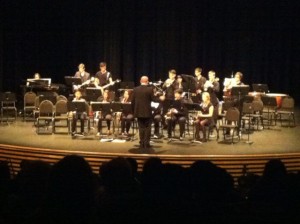Posts Tagged ‘School Board Trustee’
Ratios, Ranges, and Caps in Education
Peter Cameron, BCPSEA’s Chief Negotiator, seemed to call for a cone of silence today for Trustees when it comes to bargaining issues in the public education sector.
While I can appreciate his frustration with diverging viewpoints (solidarity matters to both parties at the bargaining table), there are many issues not being discussed in a larger context which may, in part, explain why negotiations are so acrimonious.
Which brings me to the topics I’d like to explore here: ratios for non-enrolling staff and specialist teachers, class size, and class composition.
Why?
Because if we talked about these issues in a meaningful way, apart from contract negotiations, perhaps we wouldn’t be in the same spin cycle of labour unrest every few years.
This is not an empirical study, nor an exhaustive analysis of the subject, nor does it represent the views of the West Vancouver Board of Education. These are merely personal reflections intended to stimulate debate.
Ratios for Non-Enrolling Staff and Specialists
To frame this discussion, I think we need to consider the minimally acceptable service levels for positions such as teacher-librarian, counsellor, special education teacher and so on.
Having said that, I realize that we must first agree on which of these roles is integral to providing a quality education for students. We can then determine the appropriate ratios. However, these ratios would have to reflect the needs and the realities of each local community. What may be needed in Vancouver, for example, may not work in Williams Lake, and what may be sufficient in Fort Nelson may not work on the Sunshine Coast.
Now that I think about it, perhaps this piece of the puzzle is not so easy after all!
Class Size
The key question here is can we find a balance between the needs of the employer, the working conditions for a teacher, and the students’ learning conditions? For example, if a cap of 24 students is set for Grade 3 and a school has two fully subscribed classes of 24, what happens when someone moves into the neighbourhood and wants to place their child at the local school? Does a class of 25 present a significant deterioration in the working and learning conditions of the teacher and the students? Well, it may and it may not — it depends. An even more basic question is how do we even determine the optimum number of students in a classroom?
Rather than a singular number, I wonder if a range could work within the context of a collective agreement. For example, would it be possible to have a provision whereby a Grade 3 class can be anywhere from 15 to 28? Or 18 to 26? Whatever the range, provisions would also have to be considered regarding the process by which one were to go over or under – a process which balances the rights of the District with the working conditions of the teacher with the learning environment of the student.
There are also a myriad of exceptions to consider from classes that may have a defined capacity (such as foods and shop) to ones which may comfortably extend beyond a specified range (such as choir and band).
Given the many different factors to consider, you can see how difficult it becomes to distill class size down to a singular number which would apply in all situations in all regions of the province.
Class Composition
Of the three components I identified at the start, I find this one the most difficult to assess. The key question seems to be how do we set up a system which does not discriminate against our most vulnerable students and yet takes into account acceptable working conditions for a teacher? But I do know that by not addressing class composition issues, we are potentially compromising the education of all the students in a particular classroom.
I believe the answer lies in ensuring adequate support services and resources in the classroom. By that I mean if we are going to removing a limit on the number of special needs students in a classroom, we need to make sure the teacher in that classroom has additional help, whether in the form of special education assistants or education assistants (SEA or EA) or other specialist support, to meet the needs of all the students.
So, rather than saying there may only be three students with individual educations plans (IEPs) in one class, perhaps we have to say for every three IEPs in a classroom, there is one SEA or EA assigned to that classroom. But then we face the challenge of determining the demand associated with any particular IEP because the nature of the adjustments or assistance required can vary substantively. In addition, not every student who needs additional support has an IEP and it is often these students whose needs remain unmet not because of the teacher, but because of inadequate resourcing.
And yes, whichever remedies we put in place with regard to non-enrolling staff ratios, class size, and class composition will take money, a lot of money. But we are talking about 558,985 children in BC and we are talking about the future of our democratic society and no I’m not exaggerating.
And as much as our provincial government may be focused on shrinking public education to help reduce the amount it spends, the price of not doing education well is too high to pay, for all of us.
An Open Letter to the Premier of British Columbia
Dear Christy,
I hope you don’t mind me calling you Christy. We’ve never met, but you seem to pride yourself on connecting personally with British Columbians, so I’m sure you won’t mind my use of your first name.
I think it’s critically important for women to be involved in politics at all levels of government. I ran for the first time in 2011 and was honoured when the residents of West Vancouver elected me to be one of their trustees to the Board of Education.
Given my belief that women in politics are agents for change, it is with some hope that I viewed your election as leader of the BC Liberal Party and, subsequently, as Premier.
The opportunity to have a woman at the helm of the governing party seemed to me to be an opportunity to do things differently, to do things in a manner which is more collaborative and more substantive. To rise above partisanship and to focus on the overall good of our province and not merely to wallow in ideology.
Since then I’ve grown increasingly disillusioned by your approach to politics and governing.
Why?
Because rather than being an innovator in politics, you seem to be perfecting the art of politics by photo opportunity and soundbite rather than by policy and depth.
This is perhaps most evident in your approach to public education in our province and your reaction to the decision by Justice Griffin of the BC Supreme Court.
Essentially, Justice Griffin reaffirmed her earlier finding that legislation in 2002, enacted when you were Minister of Education, was unconstitutional and that the remedies subsequently introduced were insufficient.
This means that hundreds of millions of dollars that should have been invested in the public education system have been diverted. Not only that, but in the intervening twelve years, increases in costs, inflationary increases in conjunction with downloaded costs, have outpaced increases in funding which means that Boards of Education throughout BC have done more and more with less and less.
The continuing success of Boards should not be taken as an indication that funding is adequate. Rather, it is a testament to their resilience, and the resilience of all the partner groups including parents, that our students have continued to thrive and excel.
Imagine the success we would have had if you had maintained funding according to the terms of the 2002 collective agreement!
We would have had greater equity across school districts.
We would have more successfully addressed the needs of our most vulnerable students.
We would have kept more schools open.
To argue now, in light of the court judgement, that the solution is not affordable and that it will cause irreparable harm to students is to focus on being right rather than doing what’s right.
I’m confident that Justice Griffin was not counting on a time machine to carry us back in time and I recognize that filing an appeal is an option available to you in our legal system. I also believe the time has come for you to show leadership and to do things differently.
Negotiate a new contract with the BCTF, with new parameters for September 2014, and agree to provide the additional funding which will be required to fulfill the terms of a new agreement.
That, Christy, would reaffirm my belief in the power you have, as a woman in politics, to make a difference and, in particular, to make a difference which will undoubtedly benefit students in BC’s internationally recognized public education system.
Who Will Fight For Public Education?
On December 6, Peter Fassbender, the provincial Minister of Education, spoke at the BC School Trustees Association (BCSTA) Academy. It was the first time I had heard him in-person and I found his presentation to be coercive, if not threatening. His central argument seemed to be that in these uncertain economic times Boards of Education must make hard decisions or else face the consequences. I’m still trying to decipher his meaning.
Afterwards, in one of those characteristic quick chats you have at events such as these, another Trustee said to me she felt Minister Fassbender sounded more like the Minister for Small Business and Trade than the Minister of Education. Then she said this: “If you can’t count on the Minister of Education, then who can you count on? Who will fight for public education?”
Why?
Because although there are many passionate advocates who fight for the public education system, decision-making power rests at the table in front of cabinet Ministers and the Premier. And while they may believe in the importance of education, they seem to disavow any notion that the public education system is underfunded or that we have reached a point where school districts are unable to cover additional costs without directly affecting programs and services.
With that in mind, here’s the speech I wish the Minister had delivered to the assembly after Teresa Rezansoff, the President of BCSTA, had welcomed him to the podium and after he had acknowledged our presence on traditional territories.
“Good afternoon and thank you for inviting me to share my thoughts with you today.
When Rod Allen makes his presentation on changes to the BC curriculum, he may tell you that many young people lose their first job because they aren’t able to collaborate well with others. You also know that when we talk about 21st century learning we often focus on collaboration as one of the key skills we want our young people to develop. And you know, as well as I do, that we need to model the skills we want to teach. So, as Minister of Education, I plan to do just that. Over the next four years, I’ll do my very best to ensure that the governance of the public education system in BC is pursued on a collaborative basis.
That’s why I want to start off by thanking you. I want to thank each and every Board for funding the recent wage settlement with support staff. Not only is it incumbent upon us to recognize their hard work with gratitude, it’s important to be able to compensate their efforts with fair wage increases. But I know it was tough to make the necessary adjustments to your budgets and your operational plans and I’m sorry that we weren’t able to provide you with additional resources to cover this cost item. That’s why I want you to know that the next settlement, the one we hope to arrive at with the BCTF in this round of bargaining, will be fully funded. It will be fully funded because I know it would be unreasonable to expect the costs to come out of your budgets as they are currently structured.
With regard to the BCTF, let me say how pleased I am at the tenor of dialogue we’ve been able to establish with Jim Iker and his team at the BCTF since my appointment as Minister of Education. Our relationship is off to a good start and I look forward to continuing to build on that strength. But bargaining is tough. It’s not easy. But let me assure you that while our goal in bargaining is to secure a long-term contract, we also are focused on providing a fair deal. We want a long-term solution to ensure labour peace for students and their families, and to allow the amazing educators we have in this province to focus on the new curriculum, the changes in graduation requirements we hope to introduce, and the new approaches to assessment which will enhance student learning. In other words, we want to make sure that the energies of our educators are directed to the work that they do and not the need to fight with us. That’s collaboration. The end result may be a 10-year deal; it may be something else. We won’t let go of our desire for a long-term solution, but we want our partners to know that our public commitment to a particular time frame will not trump our willingness to bargain in good faith and to secure a fair settlement.
Allow me to make another quick note about bargaining. We will be bringing down legislation in February which will detail a new bargaining structure for the public education sector. The input you’ve provided with regard to what that may look like is very much appreciated. And let me say this: whatever that new structure will look like, it will not, in anyway, compromise the role and status of locally elected school boards. Having locally elected school boards means that local issues can be dealt with in a way that is sensitive to the needs and the wants of each individual community. That makes all the difference to the way public education is delivered at the local level and that’s a point that I’ll be stressing during the core review process as well.
As you know, my cabinet colleague Bill Bennett is in charge of the core review and he is also the Minister of Energy and Mines. Bill has said publicly that there will be no consideration for school districts when it comes to the recently announced BC Hydro rate increases. I realize that increases of this magnitude have become necessary because of decisions made by previous governments and the way in which the government’s relationship with BC Hydro has been structured. We’re working on that, but I want you to know that I plan to sit down with Bill as soon as possible and to push hard to see if there isn’t something we can do to mitigate the impact on you. I need to do that because I know, as well as you do, that any additional costs to your districts without additional funding means an impact on programs and services. And that’s not what we want.
It’s not what we want because even though your resources are stretched to the limit, you’ve done a fine job of making sure our young people are getting the education they need in order to be competitive. You can see that in the OECD PISA results released this week. Isn’t it great how well our young British Columbians are doing compared to other students from around the world? Together, we’ve done a wonderful job and we have to continue to build from this position of strength. We cannot afford to be complacent; we cannot afford to neglect the system that has served us well and which is essential to the continued success of our young men and women.
And that’s why I want you to know that I am sensitive to your challenges. I have read your letters, I have listened to you, and I have heard you. Funding is one of the key challenges facing our public education system because even though we may be spending more than ever before, costs have outpaced the level of funding provided. That won’t do. That’s just not good enough.
That’s why I want you to know that at the cabinet table I am demanding more for education. Yes, I know times are uncertain. Yes, I know the budget is stretched. But I will make it clear to the Premier that if we continue to demand the best from our public education system, we must ensure that the public education system has the means by which to be the best.
Because, like you, I believe that a strong, vibrant public education system is integral to our democratic society. We need jobs, we need a robust economy, but we also need to make sure our society is well-educated so we can maximize the potential of those jobs and that economy for all British Columbians.
Who will fight for public education? I will and you will and this government will because education is a priority — for you, for me, for the children, for all of us, and for the future.
Thank you.”
The Impossibility of Knowing What Is To Be
Here’s the thing: none of us has a crystal ball. Not the pundits nor the prognosticators, some of whom have made very lucrative careers out of saying what they “know” will happen.
In fact, some say the events which shape the human experience are not the outcomes we forecast, but the unexpected occurrences to which we respond. For more on this, read The Black Swan: The Impact of the Highly Improbable by Nassim Nicholas Taleb.
I know I can’t speak to the future with certainty, but as I look towards the fall, I suspect my voice will be a dissenting one.
Why?
Because events are moving quickly in the public education sector with no clear indication of the government’s ultimate objective and yet there seems to be a general complacency about it all.
Here are three red-flag issues for me:
- The removal of the BCPSEA Board points to a profound change in the way bargaining will be conducted in the public education sector. I think BCPSEA paid the price for pursuing a path contrary to the provincial government’s vision. The board’s removal was sudden, swift, and seemingly–and mistakenly in my opinion–unlamented. Whether this is an improvement or not remains to be seen, but I am still looking for assurance that this is not the first step in a series of unilaterally determined shifts which may or may not prove to be publicly beneficial.
- A 10-year labour agreement with the BCTF is seductive and such an easy sell in the court of public opinion. But I’m not convinced, unless the deal is fully funded and increases resources significantly for students, that it can be accomplished in a fair and equitable manner. I am also not convinced that it is in the best interest of the employer as I’ve written about before here.
- Publicly elected school boards make a difference because they represent local interests and are accountable to local communities. The fact that we have a high-performing system today is due in large measure to the way districts (everyone from students to parents to trustees to staff to principals to teachers to support staff) have been able to keep the machine humming despite inadequate funding. Yes, the provincial government spends more per student now than ever before, but add up the costs that have been downloaded without being funded and the increases in expenses which haven’t been covered (including key items such as utility costs, MSP premiums, and carbon offsets) and you’ll see why there’s such a discrepancy. Yes, some boards have run into difficulties, and yes improvements can be made, but the attempt to disregard the government’s role in exacerbating the situation is disingenuous.
So while I may not be able to speak to what the future is bound to bring, I do know that I will continue to speak up and to advocate, even if I’m in the minority, because it doesn’t take a crystal ball to see that a healthy, thriving public education system is the best foundation for all our tomorrows.
A Question of Size
“We may not be big but we’re small!”
As CBC radio listeners know, that’s the motto of the Vinyl Café, the vinyl record store at the heart of Stuart McLean’s storytelling series.
I think the motto counterbalances another common theme of our times: “Bigger is Better”. A concept which often leads to trouble economically, politically, and environmentally.
The Vinyl Café motto is also a good fit for Lions Bay Community School, a primary school in School District 45 which enrolls approximately 60 students per year in kindergarten to Grade 3. A privately run preschool also operates on the premises.
In June, I attended the school’s leave-taking ceremony for its Grade 3s, a ceremony which marks their “graduation” and acknowledges their future status as intermediate students at other schools starting in September.
Lions Bay, it seems to me, is so big in what it does even though it is small.
Why?
Part of it is the setting. Nestled in the forest, the school seems to be swimming in an ocean of green.
Part of it is the architecture. Now over 30 years old, the school is built on an open-concept plan which allows an unparalleled flow between learning spaces and allows the teaching staff an exceptional amount of flexibility.
Part of it is the community. Families who choose to live in Lions Bay have made a specific lifestyle choice and they are active participants in the school because it is a major focus for the community.
There are challenges, too. Because it is so highly dependent on area demographics, enrollment at the school can only be maintained as long as there are young families in the area or willing longer-distance commuters (for example, if Squamish families or Horseshoe Bay residents were to choose the school for their children).
In addition to the excellent teaching staff, the supportive community, and the outstanding physical environment, size is something else that gives Lions Bay an edge. Being small helps the school fulfill its mission statement “to provide a safe learning environment and strive to enable students to become confident learners”.
The size of the school, in my opinion, keeps the student experience at the heart of operations by allowing a higher degree of personal attention. It has also sparked innovation in pedagogical approaches.
These factors have all combined to ensure success for these young students.
Being small can be effective.
Which brings me to the measures being taken to restructure the bargaining framework in BC’s public education system. Measures which I hope are not a prelude to regionalizing or eliminating Boards of Education.
As John Abbott, President of the 21st Century Learning Initiative, cautioned during a visit to West Vancouver earlier this year, losing local governance puts the future of learners at risk by distancing the local community from decision-making.
So here’s what I hope our provincial government and the leadership of BCSTA remember as they work together during the remaining days of summer.
Bigger is not always better.
Artwork by Lions Bay students on display in the gym.



